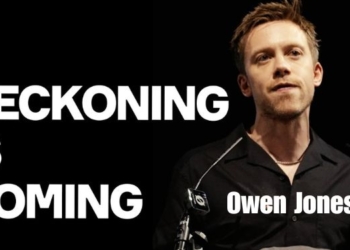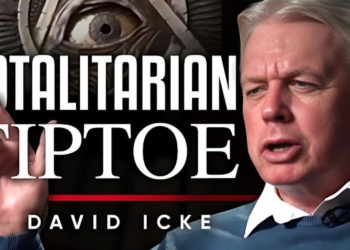
Source: Charles Eisenstein
I’m taking time off writing a long and frustrating essay to review a film I saw last night, Netflix’s popular Don’t Look Up. Spoiler alert! Maybe best to watch it first.
In the film, a planet-killing comet is headed toward earth. The world responds mostly with disbelief. Humanity lowers its eyes onto its cellphone screens, memes, celebrity news, and political spectacles, avoiding the truth of what science is plainly telling them. There is a chance to deflect the comet—but will humanity be able to unite in the seriousness of that task enough to actually accomplish it?
The film is one on level a hilarious portrait of our society at its most superficial. Its supporting characters are comically and deliberately overdrawn—but not so much that we cannot recognize their type among our public figures. Its portrayals of media and social media silliness likewise elicit uncomfortable laughter, uncomfortable because they need to exaggerate so little.
Beyond the comedic level are two layers of allegory, one social, one spiritual. What is the real-life equivalent of a planet-killing comet certain to hit the earth? What is the threat that scientists keep warning us about? That a large minority of the public disbelieves? The obvious candidate is climate change. As in the film, powerful financial interests, especially in extractive industries, seek to turn the threat to their own advantage, even at the cost of worsening the threat.1 As in the film, politicians twist the warnings of scientists into politically advantageous narratives. As in the film, the public continues blithely to live life as normal, as if nothing bad were happening. They continue to do so until the crisis literally stares them in the face.
Here the analogy wavers. For one thing, climate change is not a discrete event that a simple Newtonian calculation can locate in time. Nor does it admit to a one-shot solution such as deflecting a comet with nukes, which would allow the rest of life to proceed as normal. There is no single cause of the climate crisis—notwithstanding the obsession with reducing it to a matter of greenhouse gases.2 On this level, the film tries to fit a complex problem into a simplifying single-cause, single-response template. If only the future hung on just one threat. If only that threat came from outside ourselves. If only it could be met with force.
Today in particular the film’s background theme of “we should’ve listened to the scientists” rings hollow. In early 2020, government leaders took the dire warnings of vocal scientists very seriously and implemented authoritarian lockdown and quarantine policies. The scientists warned of tens of millions of deaths and the complete collapse of the healthcare system. These predictions turned out to be off by an order of magnitude. Then, the voice of the scientific establishment heralded mass vaccination as the solution to the crisis, assuring us that it would deflect the comet from Earth. Many of us did not believe them. Are we ignorant boobs like the public in Don’t Look Up? Or is it that we intuit what the public eventually wakes up to: “They’ve been lying to us.”
Recent developments indicate the latter.3 It is as if in the film the comet misses Earth and instead enters into orbit. Only a few fragments hit the ground, causing moderate damage. The government sustains the fear by warning the whole comet might plunge to earth at any time. It sends one array after another of nuclear devices to prevent that from happening (with great profit to their manufacturers). The first didn’t do the job—a booster is needed. And meanwhile, the radioactive fallout is causing more damage than the comet did.
Luckily, there is much more to this layered, inventive film than moralizing “we should have listened to the scientists.” That is more a trope than its main message. Its main message is timeless and timely, foreshadowed throughout the film before emerging powerfully in the last ten minutes.
You see, there is another level of allegory in the film, more intimate than climate change and more indubitable. What is this comet, come unerringly to obliterate the world? The comet is our own death, each and every one of us. While we cannot normally predict its precise timing, it is both inevitable and closes at hand. In the end, we realize: there never was that much time. Each person and each moment was precious. Like the silly people in the film, we obscure that preciousness with a parade of inanities, pretending until death stares us in the face that life isn’t finite. We, like they, are absorbed by a fake reality from which we rarely look up. Only when they actually saw the comet near at hand did they finally believe it for real, just as the reality of our own mortality truly sinks in when we have a brush with death or are present at the death of a loved one.
And what did the main characters do, when the reality of certain death sank in? They had a family dinner. They did mundane, human things—what else is there to do? Yet every moment was infused with intimacy and illuminated by grace. So it is for any of us when death makes its presence known. We don’t stop doing human things. We attend to the details of material life as before—again, what else is there to do?—but what was always mundane becomes now sacred too.
The knowledge of death restores the intimacy and grace that modern life so sorely lacks. That lack takes cinematic form in the vapid, cartoonish supporting characters of Don’t Look Up so that the remedy stands out all the more sharply.
The illness seeks medicine. We have long been hungry for an existential crisis (Y2K, Peak Oil, climate change, etc.), not only to bring us together in unity of purpose but to wake us up to what’s real.
Every alarmist prediction and every disaster film carries this truth: “We are all going to die.” Disaster movies appeal to us precisely because we so desperately need to see that. The technological recklessness that repeatedly courts calamity, poisoning earth, water, body, and genome, destroying global ecosystems, flirting with nuclear holocaust, happens in obliviousness to the preciousness of what it threatens. What medicine can deliver us from the madness swirling around civilization’s central void? (The void of sense and meaning that colors our grandest ambitions with a tinge of superficiality.) It isn’t just a news story that we need. That is secondary. We long to reconnect to the truth beyond the veil of death-denial.
The comet, therefore, represents not just doom, but for deliverance. The ego’s attempts to avoid death, whether through its own delusions or vain pursuits of actual longevity or immortality, are as hopeless as the scheme in the film to deflect the comet. Facing death in truth, we know there is something more important than avoiding it. It is to live well, in intimacy and grace. That is why Professor Mindy refused a seat on the escape ship.
Don’t Look Up brings to mind another film that explores a similar theme. It is Lars von Trier’s sublime masterpiece Melancholia, also about a huge asteroid on a collision course with Earth. It depicts the severe depression of a young woman who would rather withdraw from life entirely rather than live the pretend life that others expect of her. As the people around her crack under the pressure of impending doom, she remains calm. Having withdrawn from the drama, she is already in a sense dead. Having let go of all illusions and pretenses, the collapse of the world means little to her. But then in one of the most beautiful, quietly overwhelming cinematic closing scenes I’ve ever watched, she dispels her depression in an act of hopeless, senseless kindness, at once transcendent and mundane.
In the face of death, isn’t any act senseless? Every plan and ambition scatters as dust in the gale. Nothing is to any selfish purpose. From the ruin of the self, a new sense and purpose arise. “Nothing matters” gives birth to “everything matters.” A great light is born within the void.
I am referring here to (1) the biofuels industry, which wreaks enormous ecological damage by converting whole landscapes into industrial monocrops of jatropha, palm oil, sugar cane, and trees to be made into “climate-friendly” fuels; (2) mining for silver, cobalt, lithium, and rare earth minerals to make batteries, wind turbines, etc.; (3) mega hydropower projects that destroy crucial ecosystems, flooding some and desiccating others.
The core of the ecological crisis, in my view, is the destruction of ecosystems by mining, lumber, agriculture, urban sprawl, over-fishing, pollution, and various forms of “development.” These destroy the organs and tissues of the living being we call Earth. Thus we may easily see intensifying derangement of climate even in the absence of significant warming.










![Who Is Bobby Kennedy? [30-Minute Film on RFK Jr.’s Life, Narrated by Woody Harrelson]](https://consciouslifenews.com/wp-content/uploads/2024/05/who-is-bobby-kennedy-350x250.jpg)






